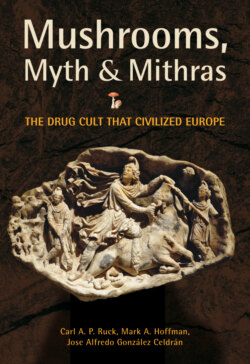Читать книгу Mushrooms, Myth and Mithras - Carl Ruck - Страница 13
На сайте Литреса книга снята с продажи.
Cap of the Covenant
ОглавлениеFor its practicioners, Mithras was the personification of a cosmic alliance, like the Biblical Covenant and Testament, the terms of accord between the human and the divine. He was named in Sanskrit as “friend” or “treaty alliance.” In Persian, his name translates as “contract.” The earliest occurrence of the god’s name is as Mitra in a Hittite document from the fourteenth century BCE, where he is invoked to endorse a treaty.17
He was the essential intercessory or mediator between god and man—the Mesites, literally the “one who is in the middle,” and hence “joins opposites,” a function also claimed for Christ. Like the alliance of Prometheus with the Olympians in Greek mythology, the role of Mithras is the essential element in the dominance of the One God.
There is one god, one also the mediator of god and man, the man Christ Jesus (mesites theou kai anthropou).
—Paul, First Epistle to Timothy, 2.5
As the “joiner,” the god’s name actually denotes his special cap. It is the Greek mitra, a band of cloth often wrapped as a turban. As the headdress of bishops and abbots it did not achieve its present form of the stiff, joined, double front and back peaked pieces until after the eleventh century,18 although this design probably perpetuates the original meaning of Mithras as the “joiner.” The miter box, which produces the joining for cabinetry, is probably similarly derived, and the root occurs in German mit and English with. The Jewish high priest wore a similar crimson linen turban, in accordance with the Lord’s commandment to Moses, as a sign of a prophet and divine power.19 It bore a plate of pure gold, engraved with the declaration “Consecrated to Yahweh.” The design of such headdresses is symbolic of what empowers the official who wears it; hence it is similar to the ornamentation of thrones.20 Ultimately, such empowerment derives from access to the spiritual realm via the ritual use of sacraments.
In such rites, the god was thought to confer sovereignty, wisdom, and worthiness upon the kings in order that they fulfill their central role as divinely mandated. Often the sovereigns assumed the god’s name, as for example with the six kings of Pontus called Mithridates, or “Given by Mithras.”
The sixth, Eupator Dionysus, known as the Great, (120–63 BCE) lent his name to the mithradatum, an herbal concoction that is an antidote to poisons, supposedly the dog’s-tooth violet, Erythronium dens canis (or perhaps the garlic germander, Teucrium Scordium). Of most importance to this tradition is the fact that it suggests the involvement of Mithraism with pharmacological experimentation. The term “mithradatum” has come to designate the practice of building resistance to poisons by taking small and increasingly larger doses of the same substance.
The most ancient meaning of the Mithraic turban-headdress is that it is a “binding” (from the root mei-, or mi-, “to bind”), a mark of “friendship,” from “to be kindly,” deriving originally from the basic root “to place“ in the sense of assembling, marshalling, and hence inspiring.21
Whether it is the winding of the headbands in a turban or the contemporary mitre of bishops (which replaced an earlier red beret cap), the headdress signifies sacred union. In the case of Mithras, it was his defining attribute, and it took the form that strongly suggests the enthoegenic mushroom—a red, white-speckled Phrygian cap. (See color figures 3, 4, and 5, p. 98.) For the initiated, the cap symbolizes their living god and the entheogen of the Covenant that binds them to the unseen transcendant realms and ultimately leads them into Cosmic Battle. Others also wore the cap in antiquity, and it often had similar connotations of a mushroom sacrament.22
The Phrygian cap, a common artistic motif.
As the bonnet rouge or liberty cap, the Phrygian cap was adopted by the extremists in the French Revolution and nurtured by secret societies like the Freemasons, where some of their most prominent members were still aware of its mushroom identity.23 It even occurs as the red cap on the stipe of a sword, the Mithraic Sword of the Accord, in the great seal of the United States Army.24
